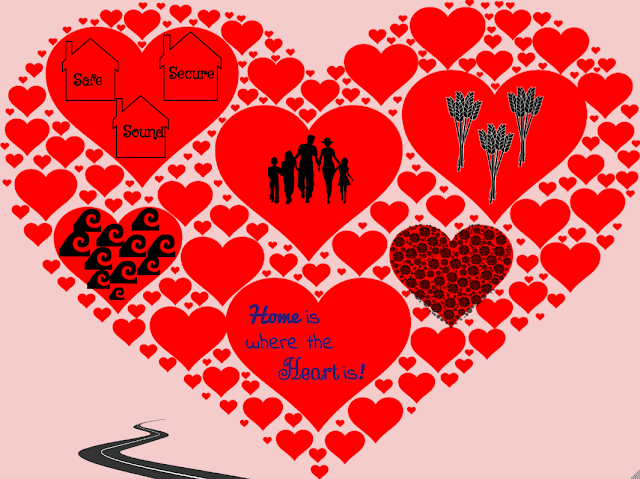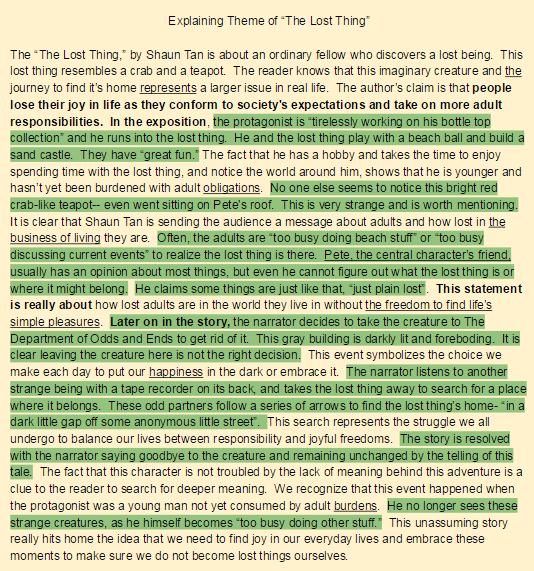9D - Lost and Found: Song Analysis Project
- Students comleted a brainstorming exercise to explore the theme lost and found. Students could write and create a list.
See Mrs. Anderson's Example Below:
Then we found songs we felt fit into the theme. We completed a close reading activity. Students read their songs and made interpretations to specific lines with deeper meaning. Then they recorded their connections to these interpretations.
Our Goals: I identify ideas that have a deeper meaning in texts and interpret them.
I compare and contrast my own life situation with themes found in a text.
See example below:
Now that we understand our songs we write a paragraph to explain the theme and our connections. See Mrs. Anderson's example below:
Students interacted with this paragraph highlighting the 3 main criteria in their own paragraphs to make sure they are effectively explaining the theme of their songs:
- use evidence from the song - GREEN
- make interpretations of these lyrics - PURPLE
- use evidence from our own lives to explain theme - PINK
Once this highlighting is done we can see what's missing and what to ADD to our writing.
After improvements, we self assessed our work with the rubric below:
Representing Theme Bumper Sticker
Goals:
- I represent the theme of my song using a different form: bumper sticker
- I use symbolic font (size, shape, and colour) images and colour to improve the meaning and feeling of my message.
- I use words with correct feeling to improve the tone of my bumper sticker and demand the audience's attention.
Can you find:
- symbolism defined
- thoughts about font size, colour, and shape
- thoughts about images
- individual interpretations of meaning
- thoughts about how the choices in the quote improve the meaning and feeling of the quote
Then we practiced word choice
I use words with an appropriate connotation (feeling behind them) to improve the tone of a bumper sticker and engage the audience.
This means my words should:
- Be appropriate
- Have a strong feeling
- Be interesting
- Create imagery
We attempted to transform this info into a bumper sticker slogan. See some of our thinking below:
50. LOVE IS THE ANSWER
LOVE IS WHY WE ARE HERE. IT IS THE FORCE FOR GOOD IN THIS SOMETIMES RANDOM AND HARSH WORLD. SHARE IT FREELY. EXPRESS IT DAILY.
Steps to help us through this process:
- Read the description then add to it. What does it mean to you?
- Underline words that are appealing and have a strong feeling.
- Create a list of things we can compare our topic to.
- Love compared to… superhero, policeman
- Love helps us survive… compare random harsh world to a storm or an angry ocean or a complicated maze
- Fly with love’s guidance… Love from others transforms us allowing us to soaring free through the sky
- Write the message as a figurative sentence.
- Change words. (synonyms with a more accurate feeling) Rearrange words. Add punctuation.
- Create several versions of the same message.
- Some things to use:
- Rhyme
- Parallel structure
- Figurative language - Simile, Metaphor, Alliteration, Onomatopoeia, Personification, Oxymoron
- Slang?
See our class ideas below:
We used the search tool in images to find:
- transparent images of houses, family, wheat, waves, roads, and hearts to add meaning and feeling to our message.
We used a text box and changed font styles, colour and size to improve meaning and feeling.
We tapped the touch pad to select background colour - pink
Students participated in musical feedback today. We examined criteria when giving feedback:
Images: Add meaning and feeling:
Students participated in musical feedback today. We examined criteria when giving feedback:
- Round 1: Word choice
Criteria for word choice:
- Words grab attention
- Message has clear meaning
- Message has a strong overall feeling
- Round 2: Symbolic Font, Colour and Image
Sizes
- Large = important dominance strength...
- Small = less important weakness, loneliness...
Shapes:
- Rounded = friendly + feelings
- Angular = hostile - feelings
Colour:
- Red - Love / Anger / Danger
- Orange - happiness / sunny
- Yellow - friendship / cowardice / polluted
- Green - nature / money / inexperience
- Blue - calmness / sadness
- Purple - royalty / night / fear
- Black - evil / fear
- White - purity / peace
Images: Add meaning and feeling:
- to individual words
- to the statement as a whole.
- Round 3: Overall Effect
- Symbolic items work together to reinforce an impression
- Layout seems balanced - nothing seems out of place or crowded












































